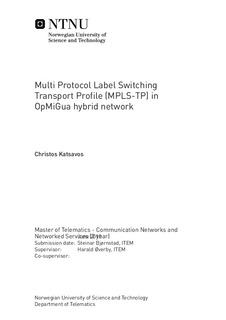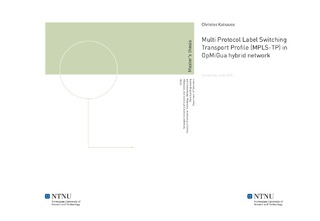| dc.description.abstract | This thesis presents the combination of MPLS-TP protocol with an integrated hybridnetwork, the Opmigua network. It is presented that the MPLS-TP protocol is applicableand follows all the requirements to be compatible with an Opmigua network. Differentnetwork scenarios, combining packet and circuit switching properties with MPLS-TPlabels, are presented. At the beginning of this thesis, are provided the characteristics and requirements of MPLS-TP protocol which the standardization of this is on going. Furthermore, it is explained how the MPLS-TP management and the forwarding plane work. Some references are also given not only to OAM mechanisms, but also to control plane that the MPLS-TP uses. We use both, global and local significance MPLS-TP labels for distinguishing theGuaranteed Service Traffic (GST) packets from Statistical Multiplexing (SM) packets.Using this method, we have concluded some results, as it concerns GST and SMtraffic. GST packets take a global significance label value until to reach the destination node. On the other hand, SM packets take local significance labels for each path into an Opmigua network which follow Optical Packet Switch (OPS) networks. We have proposed a new method for differentiation of packets from low to high priority using extension headers of Internet Protocol v6 either Destination Options Header(DOH) or MPLS-TP as an extension header. The result that we have derived is highand low priority packets are differentiated at ingress Opmigua network which GST packets take global significance MPLS-TP label following Optical Cross Connect (OXC) network and SM packets change per each Label Switched Path (LSP) local significance MPLS-TP labels until to reach the destination. Finally, two MPLS-TP path protection schemes, facility bypass and restoration usingdetours were combined with Opmigua network to provide failures for both, GuaranteedService Traffic (GST) packets and Statistical Multiplexing (SM) packets. | nb_NO |

